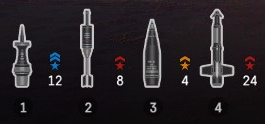
The Ammunition loadout of a vehicle, showing the three major types of ammunition and a subclass of HEAT ammunition, ATGMs.
There are different types of Ammunition in Armored Warfare. Each type of ammunition has its own advantages and disadvantages.
Armor-piercing[ | ]
Armor-piercing (AP) shells can be found on most vehicles and are represented in blue color. They deal high amount of damage with good penetration. They usually possess the highest accuracy and muzzle velocity among all types of ammunition. As much, these shells are usually considered universal.
Most AP shells will ricochet off enemy armor at 67 degrees angle or above. However, very thin armor will be penetrated by large caliber shells even when the shell impacts under very sharp angle as a result of Overmatch mechanics.
Main Battle Tanks' and Armored Fighting Vehicles' AP shells generally lose much more penetration over distance in comparison to other classes. Most AP shells start to lose penetration values at 150m, with the exception of the Leopard series tanks, which start at 250m.[1]
High-explosive anti-tank[ | ]
High-explosive anti-tank (HEAT) munitions are denoted in red. They usually possess greater damage values than AP shells of the same caliber, deal increased damage to crew and modules, and have a higher chance to set vehicle engines on fire. Unlike AP shells, HEAT does not lose its penetrative quality over distance.
HEAT also has lower accuracy and muzzle velocity when compared to AP shells. Their effectiveness is also reduced by composite armor, which tend to have better effective protection against HEAT than AP. They can also be stopped by explosive reactive armor (ERA). However, a subtype of HEAT known as HEAT-tandem (HEAT-T) can ignore or at least lose less penetration value against ERA.
Another subtype of HEAT shell is the high-explosive anti-tank multi-purpose (HEAT-MP), which can cause small amounts of damage on a non-penetrating hit.
HEAT anti-tank guided missile[ | ]
HEAT warhead anti-tank guided missiles (ATGM), which share the same red color as normal HEAT shells, share similar characteristics with their gun shell counterparts, but also tend to have even greater damage and penetration. The downside is missiles are slower and are susceptible to other interference: hard-kill active protection system (APS) can outright destroy an incoming missile in proximity, whereas soft-kill APS and smoke can cause missiles to lose control and agility, causing them to miss their targets. Furthermore, ATGMs that hit but do not penetrate a vehicle's armor can still cause a small portion of its original damage.
High-explosive[ | ]
High-explosive (HE) shells are labelled orange. They have very low penetration values, but they can still deal some damage with non-penetrating hits with a small area of effect. A penetrating hit, should one occur, can cause very heavy damage to a vehicle. HE shells can deal increased damage to modules, but they also possess lower muzzle velocity and accuracy than AP or HEAT.
High-explosive squash head[ | ]
High-explosive squash head (HESH) shells and their American counterpart, High-explosive Plastic (HEP), are represented in green color. These shells are less affected by a vehicle armor's effective thickness compared to AP and HEAT, and are therefore useful against sloped armor where AP shells tend to ricochet off due to high angle of impact. As a result, vehicles may have weakspots susceptible to HESH different from other shell types.
Although low in damage compared to other shell types, HESH shells deal bonus damage to a vehicle's internal modules and crew and have a higher chance to set vehicle engines on fire. However, as with high-explosive shells, HESH shells are less accurate and slower than AP and HEAT shells. A subtype called Piercing Intelligent Squash Head (PISH) is available only to Challenger 2 ATDU.
Thermobaric anti-tank guided missile[ | ]
Also labelled in green, these missiles behave similarly to high-explosive shells; they have low penetration values but can deal reduced damage as well as module damage even upon a non-penetrating hit, and can deal very heavy damage against light targets. Thermobaric missiles also have the largest area of effect of all ammunition types in the game.
As with HEAT ATGMs, thermobaric ATGMs are susceptible to interference from APS and smoke.
Penetrator with enhanced lateral effect[ | ]
Also denoted in green, Penetrator with enhanced lateral effect (PELE) is a shell type used by some autocannons. These shells behave like HE but with better penetration and no splash radius, and they can deal reduced damage upon non-penetrating hits.
A high caliber version also exists that is exclusive to Arjun Mk.IA and Wilk XC-8.
Kinetic energy missile[ | ]
Kinetic energy missiles (KEM) are anti-tank guided missiles that use kinetic penetrator instead of explosive warheads. Unlike ordinary AP shells, KEMs' damage and penetration value increase with distance, and unlike other ATGMs they are unaffected by APS or smoke. Such guided missiles are used by AbramsX, Bradley AAWS-H, Griffin 120mm, Lynx Skyranger, and M8 MGM-166.
White phosphorus[ | ]
White phosphorus (WP) is only available to Self-Propelled Guns and ZTZ-20. These munitions deal fixed damage over time as well as reducing all vehicles' camouflage factor to zero in an affected area.
Smoke[ | ]
Exclusive to Self-Propelled Guns, smoke shells do not deal any damage at all, but they deploy a layer of smoke in the target area, covering friendly vehicles or disrupting enemy vehicles' line of sight.
External Links[ | ]
- Armor and Ammunition - Armored Warfare Official Website
- Guide: Ammunition Types - Armored Warfare YouTube Channel
